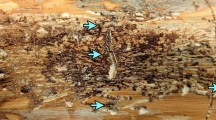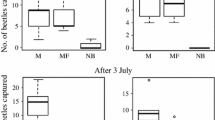Abstract
For most insect aggregations to form, they need to be started by an initial individual (the pioneer) and joined by later individuals (the joiners). Pioneers and joiners may differ with regard to characteristics such as sex and body size. We carried out three field experiments to examine the characteristics of Japanese beetles, Popillia japonica, pioneering and joining aggregations on host plants. Individual beetles were captured as they arrived on uninhabited grape plants, as well as plants designed to simulate aggregations with model beetles and feeding damage. For all experiments and treatments, the beetles arriving were significantly female-biased. Females pioneering later in the day had higher egg loads than those arriving earlier, and the results of two experiments suggested that females arriving at existing aggregations tend to have lower egg loads than females pioneering elsewhere. Male beetles found on uninhabited plants were smaller and arrived earlier in the day than males in the aggregation area of the experiment. Overall, these results indicate that female Japanese beetles may be the initiators of aggregations (i.e. the pioneers) with males joining later in the process, and suggest that females with fewer eggs and males with larger body sizes are more likely to join aggregations. We use these patterns to hypothesize on the different functions of aggregations for male and female Japanese beetles.



Similar content being viewed by others
References
Ahmad S (1982) Host location by the Japanese beetle: evidence for a key role for olfaction in a highly polyphagous insect. J Exp Zool 220:117–120
Alcock J (1998) Sleeping aggregations of the bee Idiomelissodes duplocincta (Cockerell) (Hymenoptera: Anthophorini) and their possible function. J Kans Entomol Soc 71:74–84
Allee WC (1927) Animal aggregations. Quart Rev Biol 2:367–398
Aukema BH, Raffa KF (2004) Does aggregation benefit bark beetles by diluting predation? Links between a group-colonisation strategy and the absence of emergent multiple predator effects. Ecol Entomol 29:129–138
Bernays EA, Chapman RF (1993) Host-plant selection by phytophagous insects. Chapman and Hall, New York
Clark BR, Faeth SH (1997) The consequences of larval aggregation in the butterfly Chlosyne lacinia. Ecol Entomol 22:408–415
Fleming WE (1972) Biology of the Japanese beetle. United States Department of Agriculture Technical Bulletin No. 1449
Harari AR, Ben-Yakir D, Rosen D (1994) Mechanism of aggregation behavior in Maladera matrida Argaman (Coleoptera: Scarabaeidae). J Chem Ecol 20:361–371
Held DW, Potter DA (2004) Floral characteristics affect susceptibility of hybrid tea roses, Rosa x hybrida, to Japanese beetles (Coleoptera: Scarabaeidae). J Econ Entomol 97:353–360
Held DW, Gonsiska P, Potter DA (2003) Evaluating companion planting and non-host masking odors for protecting roses from the Japanese beetle (Coleoptera: Scarabaeidae). J Econ Entomol 96:81–87
Isaacs R, Byrne DN (1998) Aerial distribution, flight behaviour and eggload: their inter-relationship during dispersal by the sweetpotato whitefly. J Anim Ecol 67:741–750
Iwabuchi K, Takahashi J (1983) Aggregative distribution pattern of the Japanese beetle, Popillia japonica Newman (Coleoptera: Scarabaeidae), and the role of former occupants in the formation of an aggregation. Appl Entomol Zool 18:324–329
Kreuger B, Potter DA (2001) Diel feeding activity and thermoregulation by Japanese beetles (Coleoptera: Scarabaeidae) within host plant canopies. Environ Entomol 30:172–180
Kruse KC, Switzer PV (2007) Physical contests for females in the Japanese beetle, Popillia japonica. J Insect Sci 7:34, insectscience.org/.34
Ladd TL (1970) Sex attraction in the Japanese beetle. J Econ Entomol 63:905–908
Lorenz MW (2007) Oogenesis-flight syndrome in crickets: age-dependent egg production, flight performance, and biochemical composition of the flight muscles in adult female Gryllus bimaculatus. J Insect Physiol 53:819–832
Loughrin JH, Potter DA, Hamilton-Kemp TR (1995) Volatile compounds induced by herbivory act as aggregation kairomones for the Japanese beetle (Popillia japonica Newman). J Chem Ecol 21:1457–1467
Loughrin JH, Potter DA, Hamilton-Kemp TR, Byers ME (1996) Role of feeding-induced plant volatiles in aggregative behavior of the Japanese beetle (Coleoptera: Scarabaeidae). Environ Entomol 25:1188–1191
Loughrin JH, Potter DA, Hamilton-Kemp TR, Byers ME (1997) Diurnal emission of volatile compounds by Japanese beetle-damaged grape leaves. Phytochemistry 45:919–923
Oliveira GA, Baptista DL, Guimaraes-Motta H, Almeida IC, Masuda H, Atella GC (2006) Flight-oogenesis sydrome in a blood-sucking bug: biochemical aspects of lipid metabolism. Arch Insect Biochem Physiol 62:164–175
Pitman GB, Vite JP (1969) Aggregation behavior of Dendroctonus ponderosae (Coleoptera: Scolytidae) in response to chemical messengers. Can Entomol 101:143–149
Potter DA, Held DW (2002) Biology and management of the Japanese beetle. Annu Rev Entomol 47:175–205
Potter DA, Loughrin JH, Rowe WJ II, Hamilton-Kemp TR (1996) Why do Japanese beetles defoliate trees from the top down? Entomol Exp et Appl 80:209–212
Rankin MA, Hampton EN, Summy KR (1994) Investigations of the oogenesis-flight syndrome in Anthonomus grandis (Coleoptera: Curculionidae) using tethered flight tests. J Insect Behav 7:795–810
Régnière J, Rabb RL, Stinner RE (1983) Popillia japonica (Coleoptera: Scarabaeidae): distribution and movement of adults in heterogenous environments. Can Entomol 115:287–294
Rowe WJ, Potter DA (1996) Vertical stratification of feeding by Japanese beetles within linden tree canopies: selective foraging or height per se? Oecologia 108:459–466
Rowe WJ, Potter DA (2000) Shading effects on susceptibility of roses, Rosa sp. to defoliation by Japanese beetles, Popillia japonica Newman. Environ Entomol 29:503–508
Saeki Y, Kruse KC, Switzer PV (2005) Male preference for large females and female reproductive condition in the Japanese beetle, Popillia japonica Newman (Coleoptera: Scarabaeidae). J Kans Entomol Soc 78:13–19
Simmons LW (2001) Sperm competition and its evolutionary consequences in the insects. Princeton University Press, Princeton
Smith LB, Hadley CH (1926) The Japanese beetle. United States Department of Agriculture Department Circular 363.
Smyth RR, Hoffmann MP (2003) A male-produced aggregation pheromone facilitating Acalymma vittatum [F.] (Coleoptera: Chrysomelidae) early-season host plant colonization. J Insect Behav 16:347–359
Switzer PV, Escajeda K, Kruse KC (2001) Pairing patterns in Japanese beetles (Popillia japonica Newman): effects of sex ratio and time of day. J Insect Behav 14:713–724
Switzer PV, Enstrom PC, Schoenick CA (2008) Environmental conditions affect sperm competition risk in Japanese beetles (Coleoptera: Scarabaeidae). Ann Entomol Soc Am 101:1154–1161
Switzer PV, Enstrom PC, Schoenick CA (2009) Behavioral explanations underlying the lack of trap effectiveness for small-scale management of Japanese beetles (Coleoptera: Scarabaeidae). J Econ Entomol 102:934–940
Thornhill R, Alcock J (1983) The evolution of insect mating systems. Harvard University Press, Cambridge
Tigreros N, Switzer PV (2009) Observations of multiple mating under field conditions for Japanese beetles (Popillia japonica Newman) (Coleoptera: Scarabaeidae). J Kans Entomol Soc 82:151–159
Tigreros N, Jadhav R, Kowles KA, Nathan BP, Switzer PV (2010) Physiological status of male and female Popillia japonica (Coleoptera: Scarabaeidae) affects mating and grouping behavior. Environ Entomol 39:892–897
Van Timmeren SJ, Switzer PV, Kruse KC (2000) Emergence and reproductive patterns in the Japanese beetle, Popillia japonica (Coleoptera: Scarabaeidae). J Kans Entomol Soc 74:17–27
Vitullo JM, Sadof CS (2007) Effects of pesticide applications and cultural controls on efficacy of control for adult Japanese beetles (Coleoptera: Scarabaeidae) on roses. J Econ Entomol 100:95–102
Wheeler D (1996) The role of nourishment in oogenesis. Annu Rev Entomol 41:407–431
Acknowledgements
We would like to A. Grau and R. Cumming for assistance in the logistics and data collection for these experiments, and E. Bollinger, A. Fritz, and two anonymous reviewers for comments previous versions of this manuscript. This project was partially supported by Eastern Illinois University and the National Research Initiative of the USDA Cooperative State Research, Education, and Extension Service, grant #2005-35302-16364, to PVS.
Author information
Authors and Affiliations
Corresponding author
Rights and permissions
About this article
Cite this article
Kowles, K.A., Switzer, P.V. Dynamics of Aggregation Formation in Japanese Beetles, Popillia japonica . J Insect Behav 25, 207–221 (2012). https://doi.org/10.1007/s10905-011-9291-7
Revised:
Accepted:
Published:
Issue Date:
DOI: https://doi.org/10.1007/s10905-011-9291-7




